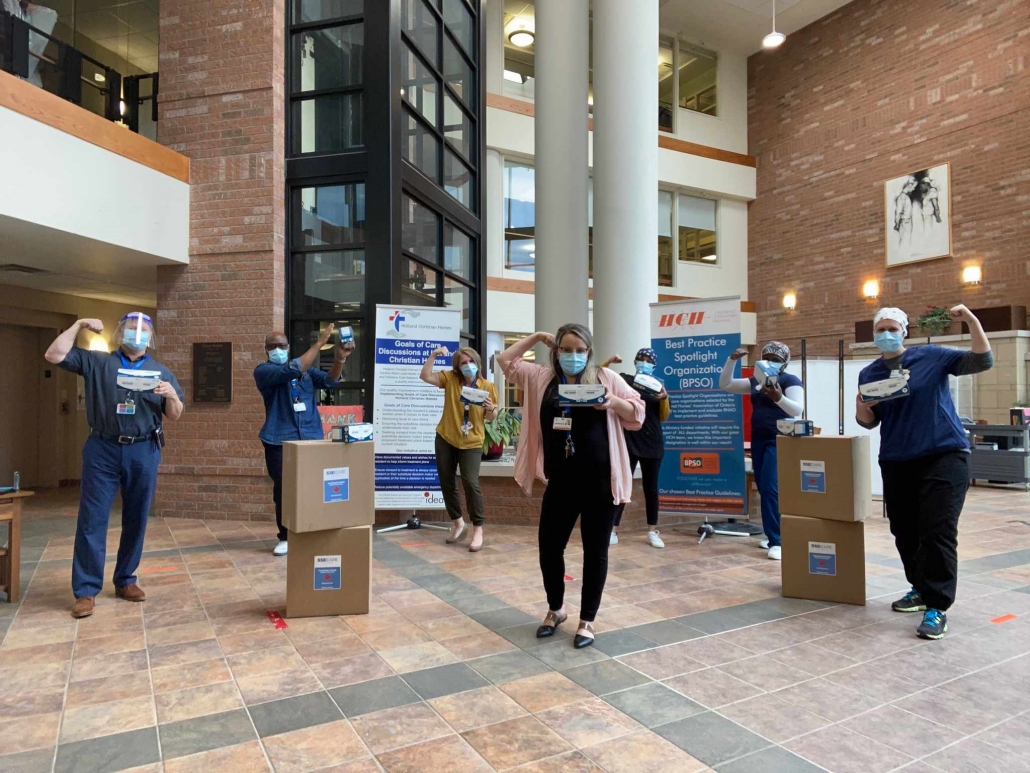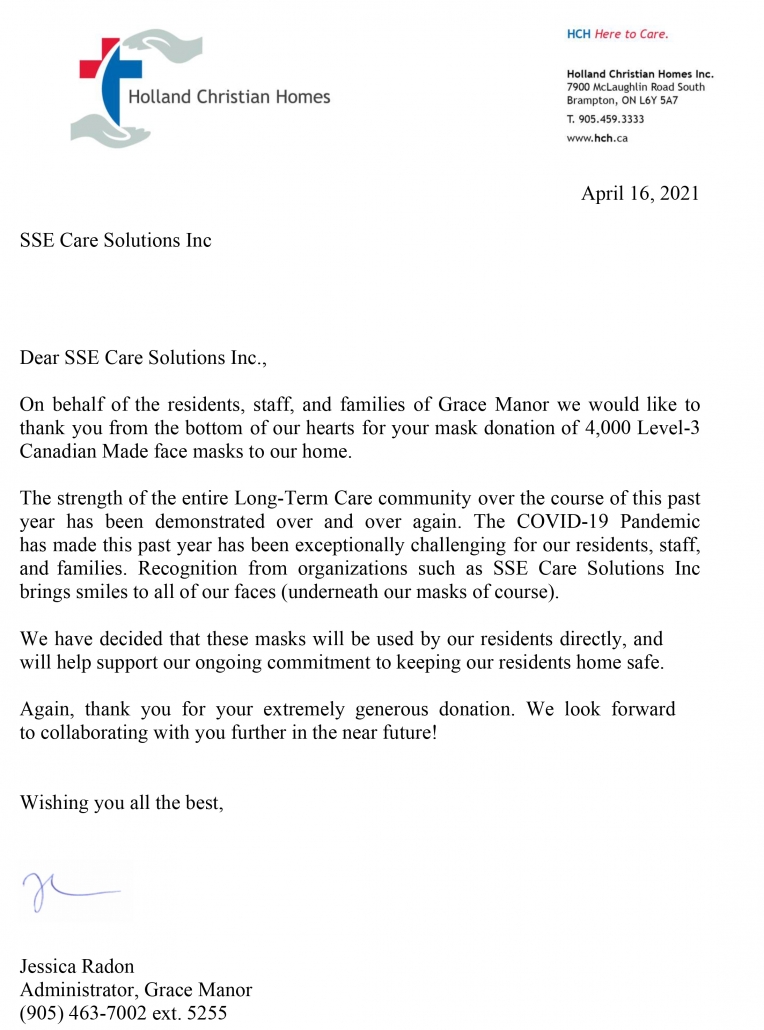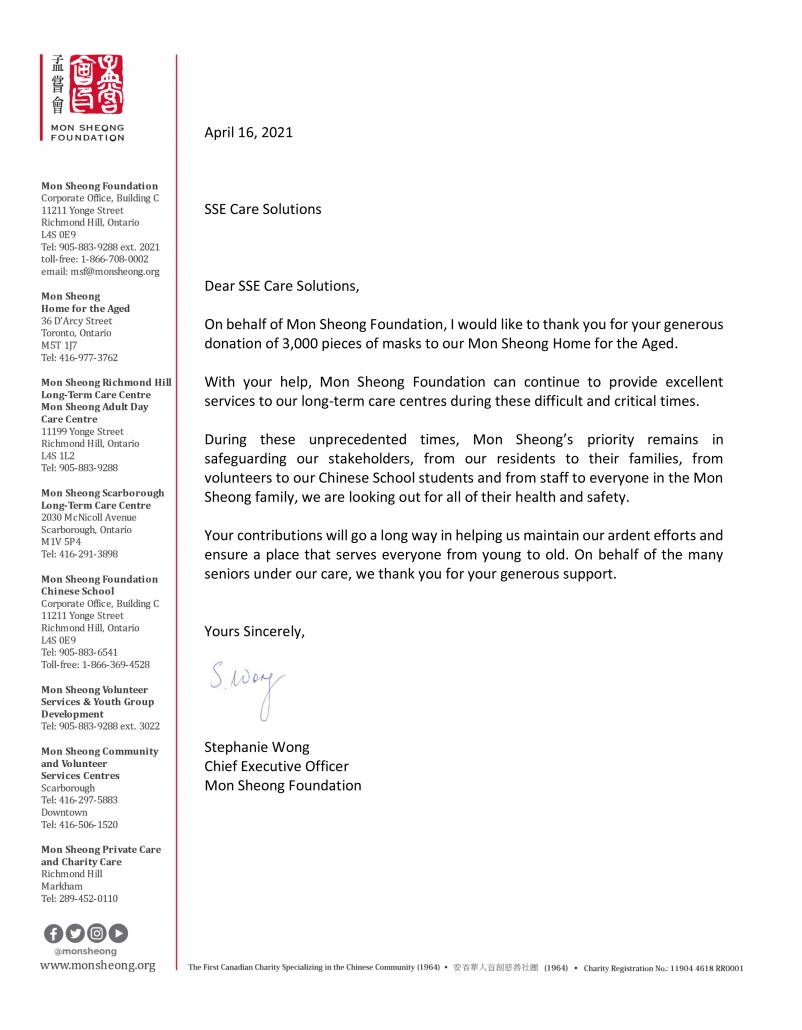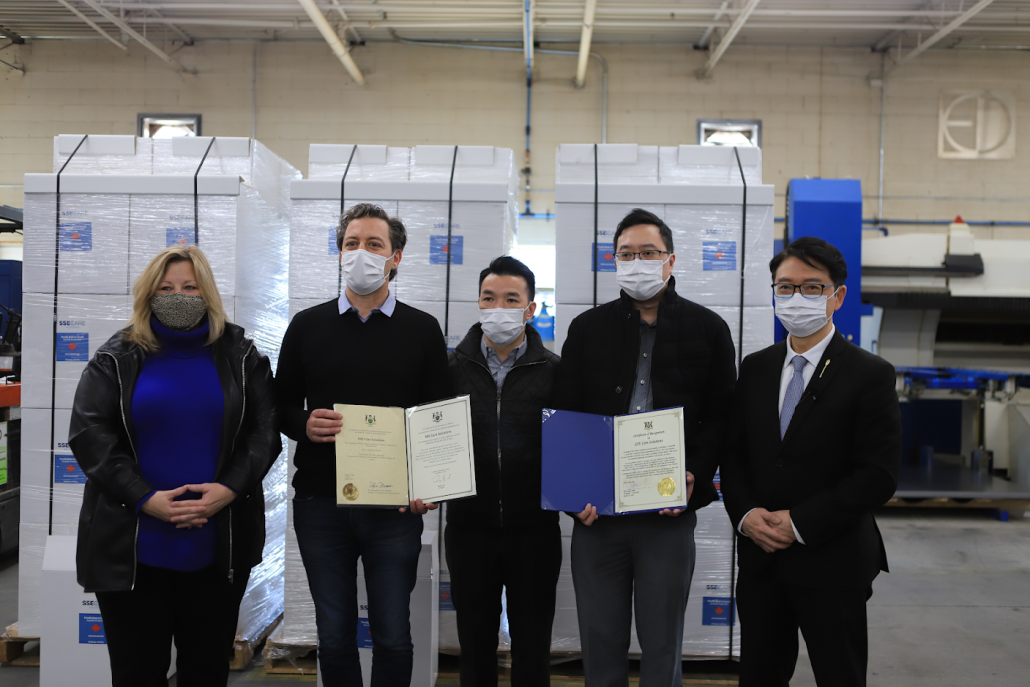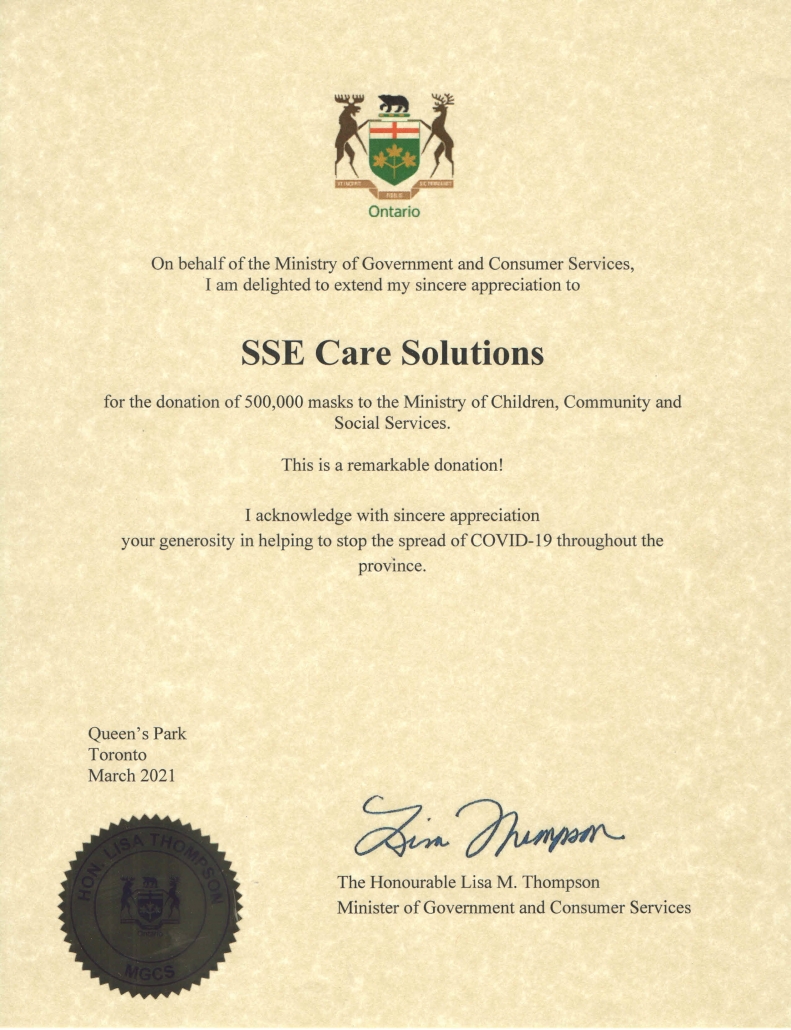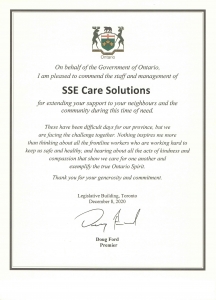SSE Care Solutions Inc. had the greatest pleasure of donating 500,000 level 3 procedure masks to the Ministry of Children, Community, and Social Services. Working with MMP Lisa Thompson and MPP Billy Pang is an extremely gratifying experience we hope to continue.
Dr. Elena Hernandez-Kucey says it’s a something dentists across North America have been talking about: a noticeable increase in stress-related dental issues during the COVID-19 pandemic.
“We are seeing more joint problems, people arriving (in clinics) saying: ‘I’m not sleeping well, I’m waking up, my face hurts,’” Hernandez-Kucey told Global News.
The Edmonton dentist explains tension and anxiety, whether a patient is aware of it or not, can cause teeth grinding and clenching.
“That might cause a fracture or complication to the nerve health of the tooth,” said Hernandez-Kucey.
Staff of the University of Alberta dental clinic have been seeing similar problems over the past year.
They’re also noticing “mask mouth.”
“Some people when they wear masks, they tend to breathe through their mouth. So this can cause dryness in the mouth,” Dr. Liran Levin told Global News.
The head of the U of A’s periodontology division explains dryness can enhance gum diseases or encourage inflammation.He also recommends drinking more water and trying to breathe through your nose while you’re wearing a mask.
Hernandez-Kucey says mask-wearing has some benefits.
If you smell your own bad breath — or halitosis — that can be a sign of potential infection, something you might not have noticed otherwise until it’s more advanced.
Patients are also taking advantage of this time when everyone’s faces are covered to hide major dental work.
“Perhaps someone might be a little bit nervous about having braces for example… or losing a front tooth… or losing all their teeth and perhaps going to a denture,” said Hernandez-Kucey.
Both dental professionals say patients who are nervous to leave the house have been putting off appointments.
“Maybe delaying what would have been an easy minor adjustment or small filling, small restoration, to now (becoming) something a lot more significant,” said Hernandez-Kucey.
Now is not to time to neglect oral health.
A recently published study from Qatar found patients with periodontitis, the most severe form of gum disease, were at least three times more likely to experience COVID-19 complications, including the need for assisted ventilation, ICU admission and death.
Source: https://globalnews.ca/news/7719939/dentists-mask-mouth-teeth-dental-stress-jaw-covid-19/
By Su-Ling Goh
Disposable masks, gloves and other types of personal protective equipment are safeguarding untold lives during the coronavirus pandemic. They’re also creating a worldwide pollution problem, littering streets and sending an influx of harmful plastic and other waste into landfills, sewage systems and oceans.
In Northern California, environmental groups are tracking the issue along the coast — and trying to do something about it.
The Pacific Beach Coalition recently noticed a dramatic increase in discarded PPE on beaches in and around the city of Pacifica, south of San Francisco, where it’s been doing monthly cleanups for nearly 25 years.
Volunteers record what they pick up to gauge what might end up in the ocean. Until 2020, the litter was mostly cigarette butts and food wrappers.
“What are we going to do? We got masks. We got gloves. We got all those hand wipes, the sani wipes. They’re everywhere. They’re in my neighbourhood, in my streets. What can we do?” asked Lynn Adams, the coalition’s president.
The group and others are calling attention to the issue, saying what’s recorded is likely only a fraction of the personal protective equipment hitting beaches and oceans.
Larger mammals can ingest PPE, and plastic from the items can disrupt the ocean’s food chains. “They’re all made of plastic,” Adams said.
A report last year by the advocacy group OceansAsia found nearly 1.6 billion masks would flood oceans in 2020 alone, based on global production estimates and other factors. OceansAsia said masks could take as long as 450 years to break down.
The Marine Mammal Center, a conservation group that rescues and rehabilitates mammals, conducts research and provides education, said animals can get trapped in discarded PPE, or mistake it for food.
“Obviously, PPE is critical right now, but we know that with increased amounts of plastic and a lot of this stuff getting out into the ocean, it can be a really big threat to marine mammals and all marine life,” said the centre’s conservation educator, Adam Ratner.
One small thing Ratner suggests is cutting the loops before discarding a mask, which can help prevent animals from getting tangled in them.
Sophia Woehl was among those volunteering in the cleanup at a beach in Pacifica last week.
“We want to keep ourselves safe, but we also want to keep the rest of the environment safe, too, and we’re not doing that right now with just leaving them on the ground,” she said.
By Haven Daley
Health Canada is warning of counterfeit 3M N95 respirators after recent seizures of counterfeit products in Canada and at the border.
Since February, Ottawa said close to 330,000 counterfeit 3M-branded N95 respirators were seized from Canadian distributors and nearly 365,000 at the border.
The new warning was issued for three versions of the 3M model, the Health Care Particulate Respirator and Surgical Mask 1860 and 1860S as well as the Aura Health Care Particulate Respirator and Surgical Mask 1870 plus.
To report counterfeit masks or other products you can call the 3M toll-free anti-fraud hotline at 1-800-426-8688, use 3M’s online form or report it to Health Canada.
Source: https://www.mystratfordnow.com/81089/health-canada-warns-of-more-fake-3m-masks/
By Mohamed Fahim
SSE Care is so lucky to be in a position where we can provide support to our community during these trying times.
Despite all the complaining people do about wearing masks due to COVID-19, polling done across three different countries shows most people say they wear a mask on a regular basis.
The survey, conducted by Maru/Blue in Canada, the United States and the United Kingdom at the end of February, shows more than 90% compliance on mask-wearing in all three countries and significant support for mask mandates.
In Canada, 97% said they wear a mask on a regular basis or sometimes. That figure was 96% in the U.K. and 94% in the United States. Just 2% of respondents in Canada and the U.K. said they refuse to wear masks, a figure that stood at 3% in the United States while the rest said they didn’t need to wear a mask where they live.
In every country, men were slightly more likely to refuse to wear a mask than women and those aged 18-34 were the most likely age group to say they were not wearing masks. Geographically, Quebec, the American west and England’s northeast were the regions most likely to refuse to wear masks.
As for how much governments should do to enforce mask wearing as a tool to combat the spread of COVID-19, a majority in Britain, 53%, said authorities had not gone far enough in making people wear masks. That contrasts with 40% who felt the same way in the U.S. and 33% in Canada.
In Canada 55% agreed with the statement that authorities had, “found the right balance in making people wear masks.”
Just 12% of Canadians, 16% of Americans, and 7% of Brits thought governments had gone too far in mandating the wearing of masks.
Source: https://torontosun.com/news/national/poll-shows-support-for-mask-mandates-across-canada-u-s-and-u-k
By Brian Lilley
“We have been concerned about this issue from the start of the pandemic as many with hearing loss struggle much more in conditions where others are wearing masks,” said Dr. Debara Tucci, who directs the National Institute on Deafness and Other Communication Disorders, a part of the National Institutes of Health.
A new study published Wednesday in PLOS One has tackled the problem by comparing four ways of masking up: using two different kinds of cloth masks, a surgical mask and an N95 mask, which filters 95% of tiny virus particles. The study did not investigate double masking.
“In the context of the pandemic, we were motivated to look at this issue more closely, since there was little previous research on how different types of masks affect speech,” said study author Joseph Toscano, an assistant professor of psychological and brain sciences who directs the cognitive science program at Villanova University in Pennsylvania.
“In high levels of background noise, the surgical mask was shown to least hinder speech recognition, said Dr. Jawad Fares, a postdoctoral research fellow in the department of neurological surgery at the Feinberg School of Medicine in Chicago’s Northwestern University.
“The findings of the study are important in light of the current pandemic, as it acknowledges the communication challenges that we are facing,” said Fares, who was not involved in the study.
WORLDWIDE PROBLEM
Statistics have shown almost 25% of people ages 65 to 74 and 50% of people over 75 in the United States have disabling hearing loss — where they wouldn’t be able to hear a vacuum cleaner, barking dog or even a baby’s cry.
And it’s not just the elderly. Globally, some 466 million people have disabling hearing loss — 34 million are children, according to the World Health Organization. One in eight people in the United States 12 years or older have some form of hearing loss in both ears.
Many people with hearing loss — and even some who don’t — rely on lip reading to follow conversational speech. That tool, of course, is removed by the use of masks during the pandemic.
The good news is that when background noise was limited, as is typical of many everyday settings, the study found cloth, surgical and N95 masks allowed speech to be conveyed effectively, Toscano said.
When background noise was loud enough that it might interfere with understanding speech, “we found that a surgical mask worked better than other masks for communication,” Toscano said.
“The finding that surgical masks cause less of a problem than cloth masks or N95 masks is interesting,” said NIDCD’s Tucci. “However, these (surgical masks) are not always available to the public, and certainly early on use of these masks was discouraged so as not to interfere with supply for use in medical facilities.”
SURGICAL MASKS
Designed to be used by surgeons and other health-care professionals, surgical-grade masks are loose-fitting, disposable devices meant to “help block large-particle droplets, splashes, sprays, or splatter that may contain germs (viruses and bacteria), keeping it from reaching your mouth and nose,” according to the U.S. Food and Drug Administration.
True medical-grade masks are made of three layers of nonwoven fabric typically made from plastic. The colored top layer of fabric is made of medical-grade spunbond polypropylene, which is a resin polymer heat-bonded into a weblike structure.
Surgical masks also have small, bendable wires to help the mask stay in place, and are often tied behind the head or secured with ear ties. Such masks are one-time use only. If they are soiled or breathing becomes difficult, the mask should be carefully discarded and replaced, the FDA said.
CLEAR MASKS ARE AN OPTION TOO
The NIDCD and the U.S. Centers for Disease Control and Prevention suggest teachers and caregivers wear clear masks or cloth masks with a see-through plastic panel when interacting with young children learning to read, students learning new languages or people with hearing loss or disabilities.
That would certainly apply to caregiving in hospitals, nursing homes and long-term care facilities, and within families of mixed generations. Now it appears that there could be a new option, Tucci said, because the study found that “intelligibility is better with surgical masks.”
“It is worth emphasizing to the public that if they are struggling to communicate — for example if they have a close family member or friend who struggles to hear — it would be worthwhile to procure either surgical masks or masks with a transparent panel to see if that is helpful,” she said.
HELPFUL HINTS
There are also many other ways to improve communication.
First, try to avoid loud background noise. Turn off the television, music and other distractions or move to a quieter area.
Modulate your voice so your speech is deliberately clear and precise. This approach was just as easily understood with a mask on as when the mask was off, a separate new study published in Cognition found. Speaking this way is much more understandable than casual or emotionally charged and hurried speech.
“Altering speech rate and vocal intensity is also helpful,” said Fares, who co-authored a December 2020 study on coping strategies to ease communication with face masks
That means slowing down the pace of your speech, even when you’re excited or upset.
Speak face to face. Another good technique is “facing the communication partner directly,” Fares said. That ensures that the “communicator has the receiver’s attention while nothing is blocking the visual field between them.”
Use nonverbal cues. This is critical for clear communication, experts said.
Face masks only cover the middle and lower parts of the face, Fares said, so speakers can use their eyebrows, eyes and upper cheeks to improve understanding.
“For example, the emotion of happiness is usually perceived when the corners of the lips rise upward. With face masks, happiness can be caught on the face by focusing on the wrinkles at the edge of the eyes,” Fares said. “The eyebrows, specifically, have been shown to help in conveying emotional expression and nonverbal communication.”
Take sadness, for example. People tend to raise the inner corners of the eyebrows, with eyelids loose, Fares explained.
“Expression of anger emphasizes the downward and central movement of eyebrows and the glaring eyes. The expressions of surprise and shock, however, are usually formed of elevated eyebrows,” he said.
Body movement can also facilitate communication. Nod in agreement, hold up a finger to request a chance to speak or lean in to show engagement. Watch the other person carefully for signs of confusion, such as lack of eye contact or slumping of the body.
Don’t be afraid to stop and ask the other person if they are having trouble. Check to make sure they understand the conversation, the NIDCD recommends. It’s also OK to write something down or use a talk-to-text application on a smartphone to facilitate communications.
Don’t take off your masks. Whatever you do, just don’t, experts say.
“First and foremost, the emphasis should be on the effectiveness of the masks for preventing the spread of the virus,” Toscano said. “Our study suggests that concerns about speech communication, on their own, don’t provide a compelling reason not to wear a mask in everyday settings.”
By Sandee LaMotte
You’re fully vaccinated against the coronavirus — now what? Don’t expect to shed your mask and get back to normal activities right away.
That’s going to be a disappointment, if not a shock, to many people.
In Miami, 81-year-old Noemi Caraballo got her second dose on Tuesday and is looking forward to seeing friends, resuming fitness classes and running errands after nearly a year of being extremely cautious, even ordering groceries online.
“Her line is, `I’m tired of talking to the cats and the parrots,”‘ said her daughter Susan Caraballo. “She wants to do things and talk to people.”
But the U.S. Centers for Disease Control and Prevention hasn’t yet changed its guidelines: At least for now, people should follow the same rules as everybody else about wearing a mask, keeping a 6-foot distance and avoiding crowds — even after they’ve gotten their second vaccine dose.
Vaccines in use so far require two doses, and experts say especially don’t let your guard down after the first dose.
“You’re asking a very logical question,” Dr. Anthony Fauci, the top U.S. infectious disease expert, responded when a 91-year-old California woman recently asked if she and her vaccinated friends could resume their mah-jongg games.
In that webcast exchange, Fauci only could point to the CDC’s recommendations, which so far are mum about exceptions for vaccinated people getting together. “Hang on,” he told the woman, saying he expected updates to the guidelines as more people get the coveted shots.
What experts also need to learn: The vaccines are highly effective at preventing symptomatic COVID-19, especially severe illness and death — but no one yet knows how well they block spread of the coronavirus.
It’s great if the vaccine means someone who otherwise would have been hospitalized instead just has the sniffles, or even no symptoms. But “the looming question,” Fauci said during a White House coronavirus response briefing last week, is whether a person infected despite vaccination can still, unwittingly, infect someone else.
Studies are underway to find out, and hints are starting to emerge. Fauci pointed to recent research from Spain showing the more coronavirus an infected person harbours — what’s called the viral load — the more infectious they are. That’s not surprising, as it’s true with other illnesses.
Some preliminary findings from Israel have suggested people infected after the first vaccine dose, when they’re only partially protected, had smaller viral loads than unvaccinated people who got infected. That’s encouraging if the findings hold up. Israel has vaccinated a large fraction of its population and scientists worldwide are watching how the outbreak responds as those inoculations increase.
Also critical is tracking whether the vaccines protect against new, mutated versions of the virus that are spreading rapidly in some countries, added Dr. Walter Orenstein, an infectious disease expert at Emory University. He’s been vaccinated and is scrupulously following the CDC guidelines.
There are practical reasons. “It’s hard to tell who got vaccinated and who didn’t if you’re just walking around the grocery store,” noted University of Pennsylvania immunologist E. John Wherry.
And experts like Wherry get asked, repeatedly: Yes, there are rules for being in public, but what’s safe for Grandma to do at home, with family or close friends, after she’s vaccinated?
Not everyone’s immune system is boosted equally from vaccines — so someone with cancer or the frail elderly may not get as much protection as a robust 70-something.
But most people should feel “more confident about going shopping, for example, or going to see your grandkids, or giving your daughter a hug,” Wherry said.
That’s because the chances of a fully vaccinated person getting seriously ill, while not zero, are low.
“Friends coming over for dinner, we should still try to follow the guidelines,” Wherry added. “You never know who is compromised, where the vaccine may not work as well.”
What if the fully vaccinated are exposed to someone who’s infected? The CDC did recently ease those rules: No quarantine as long as the vaccinated person shows no symptoms and it’s been at least two weeks but not longer than three months since their second dose.
Getting on an airplane? Vaccinated or not, the CDC still urges essential travel only.
International travel is an even tougher prospect. Expect countries that already have different quarantine and test requirements to come up with varying post-vaccination guidelines — especially since multiple types of vaccines, some better proven than others, are used around the world. There’s also the concern about carrying those worrisome mutations from one country to another.
Stay tuned for updates to the advice as more people get vaccinated. Meanwhile, don’t underestimate how important it is for the vaccinated to feel less anxiety as they run errands or go to work while still following the public health measures, said Dr. Luciana Borio, a former Food and Drug Administration scientist.
Even with a trip to the grocery store, “there was always this anxiety about, ‘Was that the contact that’s going to make me infected?”‘ Borio said. “That is a very powerful change in one’s living situation.”
By Lauran Neergaard

